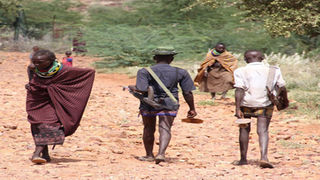
Men armed with guns at Koyasa in the Elemi.
| FileSamburu
Premium
In Suguta Valley, ‘basic education’ means learning how to use a gun
The landscape between Baragoi town and the Suguta Valley, comprising valleys and undulating hills, is one of the most beautiful in Kenya.
Suddenly, the traveller senses an element of danger a few metres to Nachola, a small dusty centre on the Baragoi-Naturkan road, when a group of about 12 armed young men appear from the bush and rocks.
Most of them are teenagers 12 to 19 years old, carrying AK-47 and American M16 assault rifles.

But they have no problem with us, because they have realised we are not 'emoit' (enemies).
With searing temperatures as high as 46 degrees Celsius, we proceeded into the infamous valley. The desolate terrain and heat were unforgiving.
We had breathing difficulties in the valley because of the massive hot-air winds mixed with dust that make the region a formidable challenge for non-locals.
But even with all this inhospitable and harsh conditions, the Suguta Valley is not lifeless. For many residents of this sparsely populated area, near the boundary of Samburu and Turkana counties, pastoralism is their economic mainstay.
Drought, an impending famine and bandits in the Suguta Valley have left the region and its people in a desperate situation.
Fresh water is hard to come by. It takes them more than six hours to bring home salty water, transporting it on their backs. Basic services such as hospitals and schools are not available.
In this part of the world, if you are a child, it is almost impossible to go to school. The nearest schools are 94km away in Nachola and Baragoi, with more than 600 children having no access to basic education.
Many families are poor, at risk of hunger, ill health, poor nutrition and violence.
Lodepe Ekiru, 11, sits on a fallen dry tree trunk with about nine other children. Some children don oversized T-shirts, most of them barefoot. Ekiru, like other children, looks emaciated. He cannot utter a single Swahili word. His mind is too busy thinking about food and water, which are scarce in this region.
He could only say “kingarakinai ng'akipi” (please help us with water).
Ekiru is one of the hundreds of children in the Suguta Valley who cannot access basic education, as formal learning is unheard of. Most children enter adulthood without basic literacy skills.
Lotir Lodukae, a 54-year-old village elder, says most school-aged boys are tasked to accompany herders to grazing fields because there is no school in the entire Suguta Valley.

Suguta Valley.
"Children spend time tending livestock. You see them? The girls have never set foot in a classroom, because we do not have one here. We are really marginalised," he says.
"We appreciate the support and labour they provide but we as parents would like to see our children in school like other Kenyans. Unfortunately, we do not have a single school in Suguta Valley."
The government’s failure to establish a single social amenity in the Suguta Valley, he says, illustrates systematic marginalisation. He argues that it is not practical to send children to Nachola Primary School, more than 90km away, on foot amid the violence in the region.
He says the region has nothing to celebrate since independence.
Area Chief James Naperit says that because there are no schools, at least 90 per cent of school-age children in the Suguta Valley stay at home or tend livestock.
"We urge the government to establish even an early childhood education centre so that the children can learn basic literacy skills," he says.
The region also lacks good roads, he says.
“We walk 90km to Nachola, which has a health centre and a school. It is too far,"
Lack of schools, he said, had promoted outdated cultural practices that have hindered development in the region.
“Girls do not go to school. Where do you expect them to be when they reach puberty? Chances are high that they may be married off early."
The impact of poverty on education in Samburu remains one of the biggest challenges, combined with natural calamities, hunger, malnutrition and decades-long insecurity.

Kenya has made great progress in increasing access to education, if free primary and day secondary education is anything to go by.
Statistics from Save the Children show that 19 percent of children are out of school due to inequity across different groups.
For instance, children in Nairobi, the capital city, complete primary school at the highest rates (98 per cent) compared with those in northeastern Kenya (53 per cent).
The agency says wealth also plays a large role: compared with children in the poorest households, those in the richest families are 45 percent more likely to have completed primary school.
It says that children from the most marginalised communities, including those with special needs and disabilities, those who are displaced (including refugees) and girls were at a higher risk of losing the gains that had been made in education.





